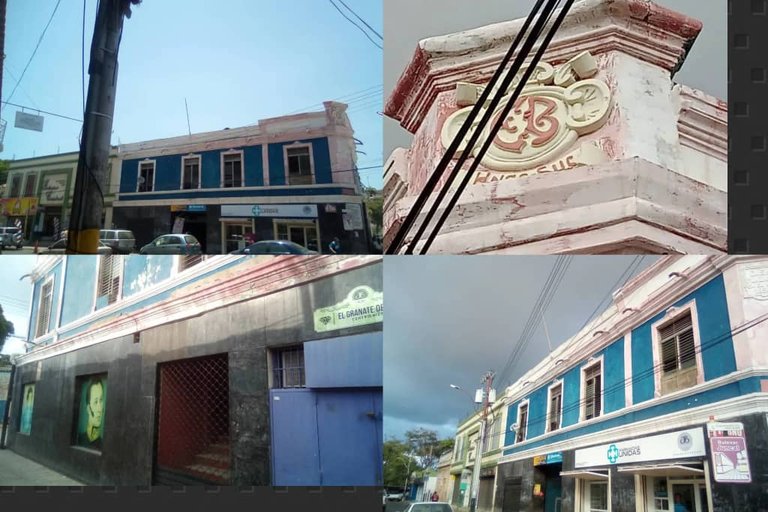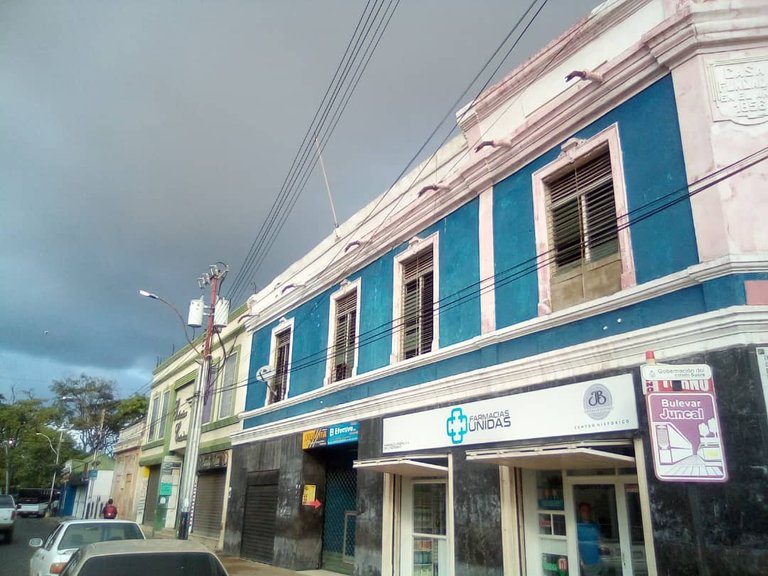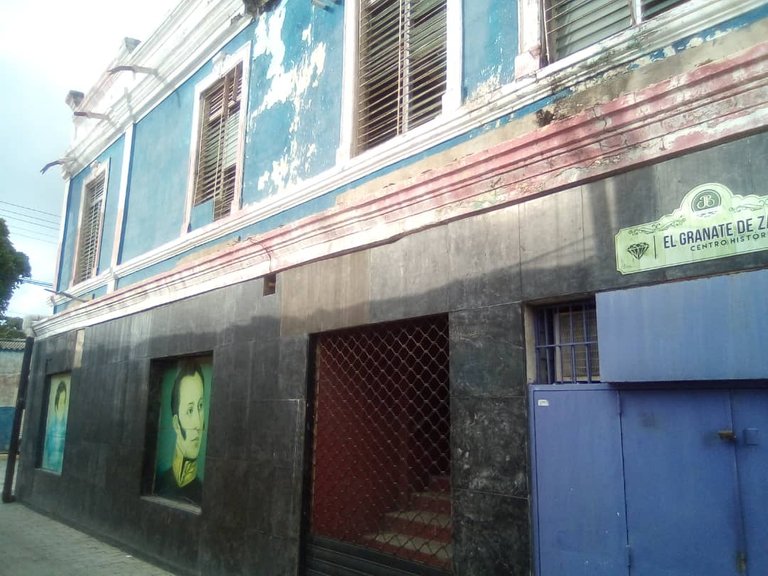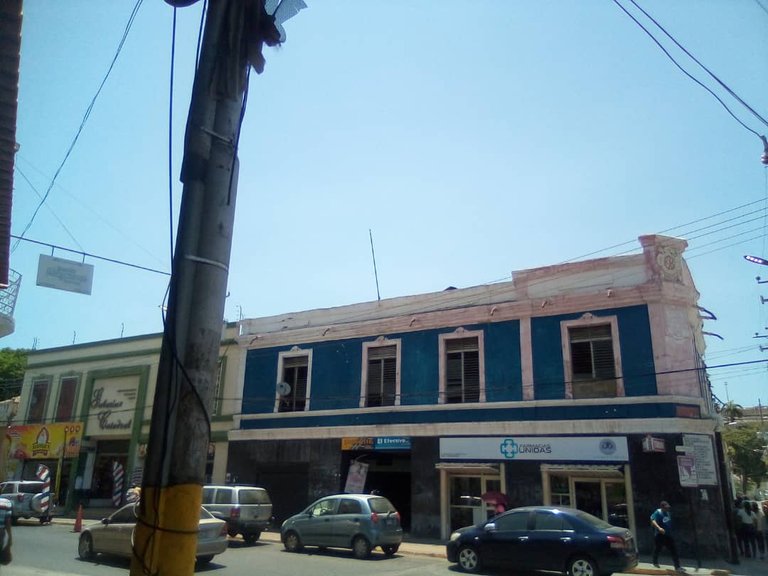
The colonial influence in the architecture and design of outstanding constructions in Venezuela still remains in force and are a sample of the legacy of the Spaniards in the American continent. Throughout the South and Central American cone you can observe fortresses, castles, government houses and institutions with a marked incidence of the colonial style.
Cumana (capital city of Sucre state) has great architectural landmarks where you can appreciate the predominance of this style of construction, which highlights numerous windows, high and wide doors, decorations in high relief with figures or shields that identified each family and their socio-economic position, while running errands in the center of the city I observed a building that stands out for its striking design and decorative elements specifically in the corner and the top floor.
La influencia colonial en la arquitectura y diseño de destacadas construcciones en Venezuela aún se mantiene vigente y son muestra del legado de los españoles en el continente americano, a lo largo del cono Sur y Centro América se pueden observar fortalezas, castillos, casas de gobierno e instituciones con marcada incidencia del estilo colonial.
Cumana (ciudad capital del estado Sucre) posee grandes hitos arquitectónicos donde se puede apreciar el predominio de este estilo de construcción, en el cual resaltan numerosas ventanas, puertas altas y anchas, decoraciones en alto relieve con figuras o escudos que identificaban a cada familia y su posición socio económica, mientras realizaba diligencias en el centro de la ciudad observé un edificio que destaca por su llamativo diseño y elementos decorativos específicamente en la esquina y la planta superior.




It is known as Bartholomé Bello building, it is located between Paradise Street and Juncal Boulevard, which gives access to the historic center of the city; in the corner of the building there is a marble plaque which describes the origin and foundation of the house, the text reads: "In this juncal street formerly known as Callejón de la Matilde in honor of Doña Matilde Odoardo mother of the wise Juan Manuel Cajigal, there was also the room of Dr. Miguel Sánchez Bello and Don Bartholomé Bello, father of the famous Don Andrés Bello, who had this house built in the year 1800, when it served the governors of the city in the year 1800, when it served as a delay to the governors of the governors of the city, who had this house built in the year 1800, when it served the governors of the city in 1800. Miguel Sánchez pesquera and Don Bartholomé Bello, father of the distinguished Don Andrés Bello, who had this house built in 1800, when the one across the street served the governors of the province. In honor to the memory of those named Dr. Luis Enrique Berrizbeitia dedicates this plaque in Cumaná in the year MCMLXXVI".
According to the information on the plaque, the house is more than two hundred years old and in its facilities operates a shopping center; Pasaje Bartholomé Bello, in the front there is a united pharmacies headquarters, the store El Trancadero, among other commercial premises, on the side that coincides with the Juncal Boulevard, are located clothing stores, stationery, jewelry and more.
On the Boulevard there are several images of Antonio José de Sucre and some of the battles in which he participated. Sucre was an outstanding hero of the independence of Venezuela and South America born in Cumaná.
Se le conoce como edificio Bartholomé Bello, está ubicado entre la calle paraíso y el Bulevar Juncal, que da acceso al centro histórico de la ciudad; en la esquina del edificio se encuentra una placa de mármol en la cual se describe el origen y fundación de la casa, el texto dice así: "En esta calle de juncal conocida antiguamente como callejón de la Matilde en honor de Doña Matilde Odoardo madre del sabio Juan Manuel cajigal, también estuvo la habitación del Dr. Miguel Sánchez pesquera y de Don Bartholomé Bello, padre del insigne Don Andrés Bello, quien hizo construir esta casa el año de 1800, cuando la de enfrente servía demorada a los gobernadores de la provincia. En honor a la memoria de los nombrados el Dr. Luis Enrique Berrizbeitia dedica esta placa en Cumaná en el año MCMLXXVI".
De acuerdo a la información en la placa, la casa tiene más de doscientos años y en sus instalaciones funciona un centro comercial; Pasaje Bartholomé Bello, en la parte frontal se encuentra una sede farmacias unidas, la tienda el Trancadero, entre otros locales comerciales, en el lateral que coincide con el Bulevard Juncal, se ubican tiendas de ropa, papelería, joyería y más.
En el Bulevar se aprecian varias imágenes de Antonio José de Sucre y algunas de las Batallas en las que participó, Sucre fue un destacado prócer de la independencia de Venezuela y Sur América nacido en Cumaná.





At the top of the cornice of the corner there is a flower design and the letters E B, in dark pink, below it reads the Hnos Suc, with colored cornices at the top and bottom; the design of the house corresponds to the colonial model, it has several windows, the corner is wide and beautiful cornices and lines decorate and mark the division of the floors of the building, in the upper cornice, in it are observed some small tubes with figures of snakes or fish emerging from the holes.
The windows have at the top a trapezoid shape, on the sides ribbons in high relief in pink, this house is striking for its great design and marble coating in black, on the side walls and corner, according to information from a kind old man born in the city, it is believed that Don Bartholomé Bello, father of the illustrious Don Andres Bello, one of the teachers of the Liberator, is believed to be the owner of the house and lived in it for more than a decade while he was an administrator in the province of Cumana, over the years the house has undergone maintenance and restoration work trying as much as possible to maintain the original design; on many occasions I have passed by this place and I had not really noticed the structure of the house and its striking decorative elements in the windows, walls and column, a repair on the upper floor would be very good and would increase its potential and durability, this house is definitely a jewel of colonial architecture and it was exciting to know a little of its history.
En la parte superior de la cornisa de la esquina se observa un diseño de flor y las letras E B, en color rosa oscuro, debajo se lee la Hnos Suc, con cornisas de color en la parte de arriba e inferior; el diseño de la casa corresponde al modelo colonial, tiene varias ventanas, la esquina es amplia y hermosas cornisas y líneas decoran y marcan la división de los pisos del edificio, en la cornisa superior, en ella se observan unos pequeños tubos con figuras de serpientes o peces que emergen de los orificios.
Las ventanas tienen en la parte superior una forma de trapecio, a los lados cintas en alto relieve en color rosa, esta casa llama la atención por su gran diseño y recubrimiento de mármol en color negro, en las paredes laterales y esquina, de acuerdo a la información de un amable anciano nacido en la ciudad, se cree que Don Bartholomé Bello, padre del ilustre Don Andrés Bello, uno de los maestros del Libertador, es el dueño de la casa y la habitó durante más de una década mientras ejercía funciones administrativas en la provincia de Cumaná, a lo largo de los años a la casa se le han hecho trabajos de mantenimiento y restauración tratando en lo posible de mantener el diseño original; en muchas ocasiones he pasado por este lugar y realmente no había notado la estructura de la casa y sus llamativos elementos decorativos en las ventanas, paredes y columna, una reparación en el piso superior le vendría muy bien e incrementaría su potencial y durabilidad, esta casa definitivamente es una joya de la arquitectura colonial y fue emocionante conocer un poco de su historia.




Blessings!

¡Bendiciones!

Código Pinmapple: [//]:# (!pinmapple 5.64435 lat -65.30273 long d3scr)
Translated with https://www.deepl.com/translator
All images are my own, captured by a Síragon LC-3000 camera.
Todas las imágenes son de mi autoría, capturadas por una cámara Síragon LC-3000.

